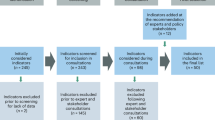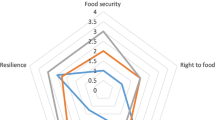Abstract
Many conceptual frameworks have been developed to facilitate understanding and analysis of the linkages between agriculture and food security. Despite having usefully guided analysis and investment, these frameworks exhibit wide diversity in perspectives, assumptions and application. This Review Article examines this diversity, providing an approach to assess frameworks and suggesting improvements in the way they are specified and applied. Using criteria-based systems modelling conventions, we evaluate 36 frameworks. We find that many frameworks are developed for the purpose of illustration rather than analysis and do not clearly indicate causal relationships, tending to ignore the dynamic (stability) dimensions of agriculture and food security and lacking clear intervention points for improving food security through agriculture. By applying system modelling conventions to a widely used framework, we illustrate how such conventions can enhance the usefulness of a framework for overall illustration purposes, delineate hypotheses on agriculture–food security links and examine potential impacts of interventions.
This is a preview of subscription content, access via your institution
Access options
Access Nature and 54 other Nature Portfolio journals
Get Nature+, our best-value online-access subscription
$29.99 / 30 days
cancel any time
Subscribe to this journal
Receive 12 digital issues and online access to articles
$119.00 per year
only $9.92 per issue
Buy this article
- Purchase on Springer Link
- Instant access to full article PDF
Prices may be subject to local taxes which are calculated during checkout



Similar content being viewed by others
References
Béné, C. P. et al. When food systems meet sustainability – Current narratives and implications for actions. World Dev. 113, 116–130 (2019).
Sterman, J. D. Learning from evidence in a complex world. Am. J. Public Health 95, 505–514 (2006).
Nicholson C. F. et al. Setting Priorities to Address the Research Gaps Between Agricultural Systems Analysis and Food Security Outcomes in Low- and Middle-income Countries (CGIAR, CCAFS, 2019).
Compendium of Indicators for Nutrition-sensitive Agriculture (Food and Agriculture Organization of the United Nations, 2016).
Jones, A. D., Ngure, F. M., Pelto, G. & Young, S. L. What are we assessing when we measure food security? A compendium and review of current metrics. Adv. Nutr. 4, 481–505 (2013).
Sterman, J. D. Business Dynamics: Systems Thinking and Modeling for a Complex World (Irwin/McGraw-Hill, 2000).
Headey, D., Chiu, A. & Kadiyala, S. Agriculture’s Role in the Indian Enigma: Help or Hindrance to the Undernutrition Crisis? (IFPRI, 2011).
Kadiyala, S., Harris, J., Headey, D., Yosef, S. & Gillespie, S. Agriculture and nutrition in India: mapping evidence to pathways. Ann. N. Y. Acad. Sci. 1331, 43–56 (2014).
Randolph, T. F. et al. Role of livestock in human nutrition and health for poverty reduction in developing countries. J. Anim. Sci. 85, 2788–2800 (2007).
Dobbie, S. & Balbi, S. in Advances in Social Simulation 2015 (eds Jager, W. et al.) 81–94 (Springer, 2017).
Garrett, J. What to Do: Frameworks for Improving Nutrition through Agriculture and Food Systems (Bioversity International, 2017); https://go.nature.com/3fYrHEv.
Kanter, R., Walls, H. L., Tak, M., Roberts, F. & Waage, J. A conceptual framework for understanding the impacts of agriculture and food system policies on nutrition and health. Food Secur. 7, 767–777 (2015).
Sassi, M. in Understanding Food Insecurity Ch. 2 (Springer, 2018).
Spotlight on Jo Goossens and the shiftN Global Food Systems Map. Cereal Foods World https://doi.org/10.1094/CFW-64-1-0010 (2019).
Wossen, T., Berger, T., Haile, M. G. & Troost, C. Impacts of climate variability and food price volatility on household income and food security of farm households in East and West Africa. Agric. Syst. 163, 7–15 (2018).
Acharya, T. et al. Assessing Sustainable Nutrition Security: The Role of Food Systems (ILSI Research Foundation, Center for Integrated Modeling of Sustainable Agriculture and Nutrition Security, 2014); https://go.nature.com/3l1hlHE
Emergency Food Security Assessment Handbook (World Food Programme, 2009).
Strategy for Improved Nutrition of Children and Women in Developing Countries (UNICEF, 1990).
Tendall, D. M. et al. Food system resilience: Defining the concept. Glob. Food Secur. 6, 17–23 (2015).
Burchi, F., Fanzo, J. & Frison, E. The role of food and nutrition system approaches in tackling hidden hunger. Int. J. Environ. Res. Public Health 8, 358–373 (2011).
Allen, T. & Prosperi, P. Modeling sustainable food systems. Environ. Manag. 57, 956–975 (2016).
Ericksen, P. J. Conceptualizing food systems for global environmental change research. Glob. Environ. Change 18, 234–245 (2008).
Ingram, J. A food systems approach to researching food security and its interactions with global environmental change. Food Secur. 3, 417–431 (2011).
Carpenter, S. R. et al. Science for managing ecosystem services: Beyond the Millennium Ecosystem Assessment. Proc. Natl Acad. Sci. USA 106, 1305–1312 (2009).
Ericksen, P. J., Ingram, J. S. I. & Liverman, D. M. Food security and global environmental change: emerging challenges. Environ. Sci. Policy 12, 373–377 (2009).
Holling, C. S. Understanding the complexity of economic, ecological, and social systems. Ecosystems 4, 390–405 (2001).
Thompson, J. & Scoones, I. Addressing the dynamics of agri-food systems: an emerging agenda for social science research. Environ. Sci. Policy 12, 386–397 (2009).
Hammond, R. A. & Dubé, L. A systems science perspective and transdisciplinary models for food and nutrition security. Proc. Natl Acad. Sci. USA 109, 12356–12363 (2012).
Institute of Medicine and National Research Council A Framework for Assessing Effects of the Food System (The National Academies Press, 2015).
Lawrence, M. A., Friel, S., Wingrove, K., James, S. W. & Candy, S. Formulating policy activities to promote healthy and sustainable diets. Public Health Nutr. 18, 2333–2340 (2015).
Horton, P., Koh, L. & Guang, V. S. An integrated theoretical framework to enhance resource efficiency, sustainability and human health in agri-food systems. J. Clean. Prod. 120, 164–169 (2016).
Ashley, C. & Carney, D. Sustainable Livelihoods: Lessons from Early Experience (Department for International Development, 1999).
Nutrition at the World Food Programme: Programming for Nutrition-Specific Interventions (World Food Programme, 2012).
UNICEF The State of the World’s Children 1998 (Oxford University Press, 1998).
Pinstrup-Andersen, P. & Watson, D. D. II Food Policy for Developing Countries: The Role of Government in Global, National, and Local Food Systems (Cornell University Press, 2011).
High-level Panel of Experts Nutrition and Food Systems: A Report by the High-level Panel of Experts on Food Security and Nutrition (Committee on World Food Security, 2017).
Hawkes C., Turner, R. & Waage, R. Current and Planned Research on Agriculture for Improved Nutrition: A Mapping and a Gap Analysis (Leverhulme Centre for Integrative Research on Agriculture and Health, 2012).
Gillespie, S., Harris, J., Kadiyala, S. The Agriculture–Nutrition Disconnect in India: What Do We Know? (IFPRI, 2012)
Hawkes, C. Identifying innovative interventions to promote healthy eating using consumption-oriented food supply chain analysis. J. Hunger Environ. Nutrit. 4, 336–356 (2009).
Ecker, O. & Breisinger, C. The Food Security System: A New Conceptual Framework (International Food Policy Research Institute, 2012).
Guidelines for National Food Insecurity and Vulnerability Information and Mapping Systems (FIVIMS): Background and Principles (Food and Agriculture Organization of the United Nations, Committee on World Food Security, 1998).
Wegener, J., Raine, K. D. & Hanning, R. M. Insights into the government’s role in food system policy making: Improving access to healthy, local food alongside other priorities. Int. J. Environ. Res. Public Health 9, 4103 (2012).
Global Nutrition Report 2016: From Promise to Impact: Ending Malnutrition by 2030 (IFPRI, 2016)
Herforth, A. & Ballard, T. J. Nutrition indicators in agriculture projects: Current measurement, priorities, and gaps. Glob. Food Secur. 10, 1–10 (2016).
Fanzo, J. C., Downs, S., Marshall, Q. E., de Pee, S. & Bloem, M. W. in Nutrition and Health in a Developing World (eds de Pee, S. et al.) Ch. 34, 753–770 (Springer, 2017).
Rutten, M. et al. Metrics, models and foresight for European sustainable food and nutrition security: The vision of the SUSFANS project. Agric. Syst. 163, 45–57 (2018).
de la Peña, I., Garrett, J. & Gelli, A. Nutrition-sensitive Value Chains from a Smallholder Perspective: A Framework for Project Design (IFAD, 2018).
Habicht, J. P., Victora, C. G. & Vaughan, J. P. Evaluation designs for adequacy, plausibility and probability of public health programme performance and impact. Int. J. Epidemiol. 28, 10–18 (1999).
Meadows, D. H. Leverage Points: Places to Intervene in a System (The Sustainability Institute, 1999).
Vennix, J. A. M. Group Model Building: Facilitating Team Learning Using System Dynamics (Wiley, 1996).
Senge, P. M. The Fifth Discipline: The Art and Practice of the Learning Organization (Doubleday, 1990).
Meadows, D. H. Thinking in Systems: A Primer (ed. Wright, D.) (Earthscan, 2008).
Nicholson, C. F. et al. Food security outcomes in agricultural systems models: Case examples and priority information needs. Agric. Syst. (in the press).
Maru, Y. T. et al. Towards appropriate mainstreaming of “Theory of Change” approaches into agricultural research for development: Challenges and opportunities. Agric. Syst. 165, 344–353 (2018).
Strengthening Action to Improve Feeding of Infants and Young Children 6–23 Months of Age in Nutrition and Child Health Programmes (WHO, 2009).
Rogers, P. J. Causal models in program theory evaluation. New Dir. Eval. 87, 47–55 (2000).
Lipsey, M. W. Evaluation methods for social intervention. Annu. Rev. Psychol. 51, 345–375 (2000).
Olney, D. et al. Using program impact pathways to understand and improve program delivery, utilization and potential for impact of Helen Keller International’s homestead food production program in Cambodia. Food Nutr. Bull. 34, 169–184 (2013).
Kim, S. S., Habicht, J.-P., Menon, P. & Stoltzfus, R. J. How Do Programs Work to Improve Child Nutrition? Program Impact Pathways of Three Nongovernmental Organization Intervention Projects in the Peruvian Highlands (IFPRI, 2011).
Rawat, R. et al. Learning how programs achieve their impact: Embedding theory-driven process evaluation and other program learning mechanisms in alive & thrive. Food Nutr. Bull. 34, S212–S225 (2013).
Mbuya, M. N. N. et al. Theory-driven process evaluation of the shine trial using a program impact pathway approach. Clin. Infect. Dis. 61, S752–S758 (2015).
Guariguata, L. et al. Using group model building to describe the system driving unhealthy eating and identify intervention points: a participatory, stakeholder engagement approach in the Caribbean. Nutrients 12, 384 (2020).
Acknowledgements
We gratefully acknowledge financial support from CGIAR Research Program on Climate Change, Agriculture and Food Security (CCAFS). We appreciate previous input from P. Thornton and J. Bogard.
Author information
Authors and Affiliations
Contributions
All authors contributed to the development of the structure of the article and the criteria for assessment. C.F.N., B.K. and E.C.S. wrote the first draft, with subsequent input from the other authors. B.K. and E.C.S. developed the summary in Table 3, and C.F.N. developed the application of systems modelling tools to the Kadiyala et al. framework.
Corresponding author
Ethics declarations
Competing interests
The authors declare no competing interests.
Additional information
Publisher’s note Springer Nature remains neutral with regard to jurisdictional claims in published maps and institutional affiliations.
Supplementary information
Supplementary Information
Supplementary Table 1 and Supplementary Fig. 1
Rights and permissions
About this article
Cite this article
Nicholson, C.F., Kopainsky, B., Stephens, E.C. et al. Conceptual frameworks linking agriculture and food security. Nat Food 1, 541–551 (2020). https://doi.org/10.1038/s43016-020-00142-3
Received:
Accepted:
Published:
Issue Date:
DOI: https://doi.org/10.1038/s43016-020-00142-3
This article is cited by
-
Analysis of India’s agricultural ecosystem using knowledge-based Tantra framework
CSI Transactions on ICT (2023)



